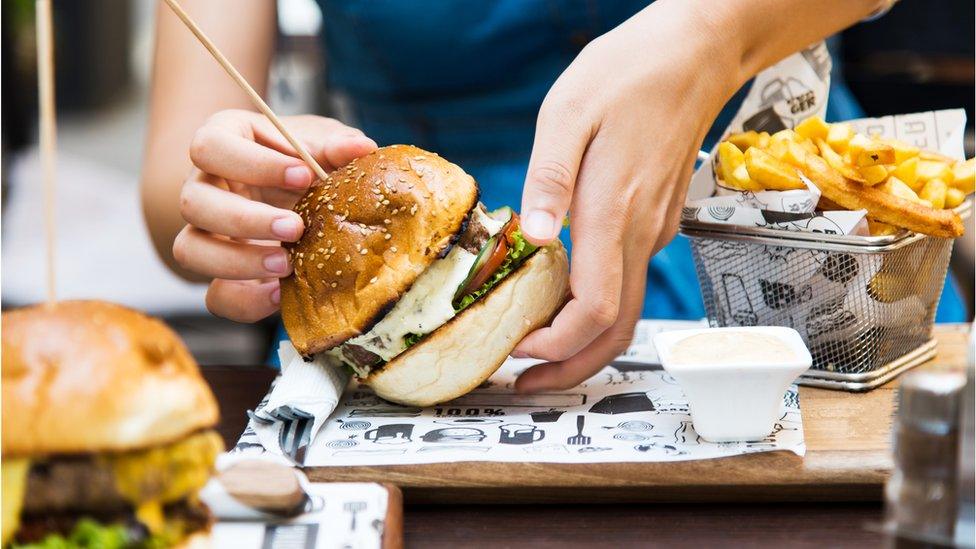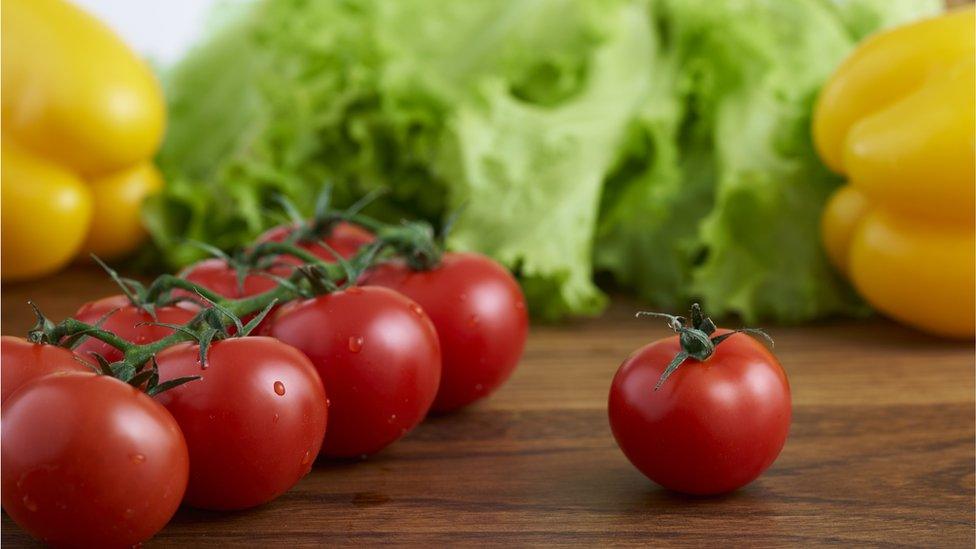Restaurant dishes 'contain more calories than fast-food meals'
- Published
- comments

Only one in 10 restaurant meals analysed was classed as healthy or fewer than 600kcal
The calorie content of meals in UK restaurants is "excessive" and sit-down restaurants are unhealthier than fast-food chains, BMJ research suggests., external
Health experts say meals should not exceed 600 calories, but in this study they averaged 1,033 in restaurants and 751 in fast-food chains.
University of Liverpool researchers analysed thousands of meals from places like Hungry Horse and McDonald's.
They said their findings were a cause for concern.
The research team looked at more than 13,500 meals on the menus of 21 sit-down restaurants and six fast-food chains.
By using online company information on calorie content, only one in 10 meals was classed as healthy or fewer than 600kcal, as recommended by Public Health England.
And nearly half of the meals contained 1,000kcal or more.
Sit-down restaurants were five times more likely to offer high-calorie meals of 1,000kcal or more than fast-food restaurants, the research found.
Dr Eric Robinson, lead researcher from Liverpool's department of psychological science, said the results were "shocking" but probably underestimated the calories consumed in restaurants.
"We don't know about energy intake but 'plate clearing' is a common behaviour.
"Our analysis did not include drinks, starters, desserts or side orders."
Hungry Horse restaurants had the highest average meal calorie content of 1,358kcal.

To take away or not to take away?
Chains including Flaming Grill, Stone House and Sizzling Pubs were not far behind, with an average of 1,200kcal per meal.
KFC topped the fast-food list with an average of 987 calories per meal offered. Burger King, McDonald's and Subway were around 700kcal.
Even when the study compared similar meals, the energy content in restaurant meals was greater.
Burger meals in restaurants contained an average of 414kcal more than burger meals in fast-food chains, while salad meals in restaurants were slightly higher in calories on average than fast food salads.
Dr Robinson said portion size, the ingredients used and cooking methods could explain the difference, but he said the food industry had to make changes.
"It's really clear what the food industry need to do. They need to act more responsibly and reduce the number of calories that they're serving."

Food prepared and eaten at home is generally lower in calories, research shows
Hungry Horse said it offered something for everyone at good value.
A spokesperson for the chain said: "We have been working hard to increase the range of lower calorie options, including recently launching a dedicated Live Well range with dishes under 600 calories, and we are committed to further changes."
The government is currently consulting on a plan to introduce mandatory calorie labelling in restaurants, takeaways and cafes, which is likely to finish in the new year.
'Prices going up'
Kate Nicholls, chief executive of trade association UKHospitality, said restaurants, pubs and other hospitality businesses were already taking action to reduce calories and offer healthier dishes - but there were costs to consider too.
"Proposals to shrink the size of dishes or cap calories would be yet another burden for hard-pressed operators to absorb, resulting in prices going up and investment in businesses going down; inevitably negatively impacting the overall customer experience."
Dr Robinson said research showed that meals eaten out of the home contained more calories and with more people having restaurant food delivered to their homes using online services, the problem could be getting worse.
The study relied on information provided online by restaurant chains on calorie content. Very few provided calorie labelling on their menus.
The researchers said it was possible the fast-food sector was now offering more lower-energy meals and healthier options, after pressure from campaigners to do so.
- Published6 November 2018

- Published19 September 2018

- Published16 August 2018
